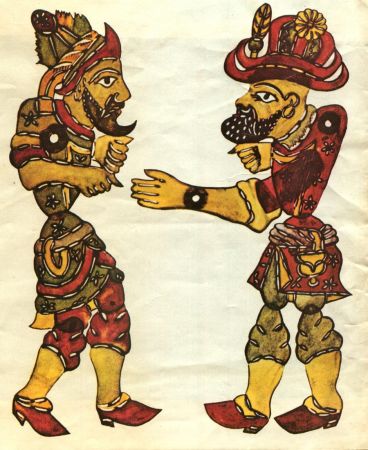Traditional Galanty Show - Karagöz and Hacivat
- Written by Portal Editor
- Traditional drama (Light comedy)
Our shadow play KARAGÖZ HACIVAT, being a cornerstone of our traditional culture’s galanty show and fairytale teller and mimic, were created centuries ago.
They made the public think while laughing and from time to time had a leading role in the creation of social consciousness.
Galanty Show, which depends on the reflection of the portrayals’ shadows made of leather on a white screen, is an art special to eastern cultures and there are different stories about their emergence.
The king later suffers from his decision
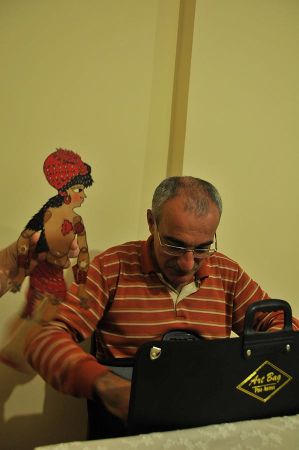 While there is no definite information when the Shadow Play technique was first used in the Turkish society, there are different views about its emergence in the Turkish culture and when it took the form of Karagöz and Hacivat. The most common one among these takes place at the construction of Ulucami in Bursa during the Sultan Orhan period (1324-1362).
While there is no definite information when the Shadow Play technique was first used in the Turkish society, there are different views about its emergence in the Turkish culture and when it took the form of Karagöz and Hacivat. The most common one among these takes place at the construction of Ulucami in Bursa during the Sultan Orhan period (1324-1362).
Workers, who want to listen to the humorous conversations between ironmaster Kambur Bâli Çelebi (Karagöz) and bricklayer master Halil Hacı İvaz (Hacivat), stop working and gather around them, thus slowing the construction work. Upon hearing about this, Sultan commands the execution of both of them. (According to another rumor, Karagöz is executed and Hacivat died on the way while going to pilgrimage in Mecca).
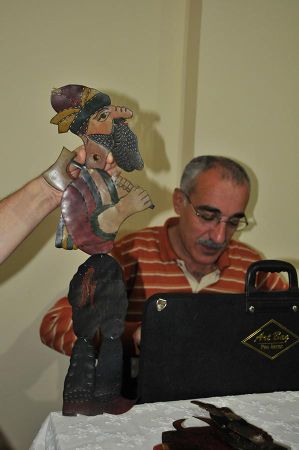 Şeyh Küşteri, who wants to cheer the repented Sultan afterwards, stretches his white turban cloth by taking it off from his head and by lighting a candle behind it, and characterizes the Karagöz and Hacivat with his taken off shoes and repeats the humorous conversations. After that date, Karagöz and Hacivat plays started to be performed in different locations. Today, Karagöz screen is called as Şeyh Küstari arena and Şeyh Küstari is regarded as the master of Karagöz performances. First definite document about Karagöz is from Surname-i Humayun dated 1582 and explaining the prince’s circumcision feasts.
Şeyh Küşteri, who wants to cheer the repented Sultan afterwards, stretches his white turban cloth by taking it off from his head and by lighting a candle behind it, and characterizes the Karagöz and Hacivat with his taken off shoes and repeats the humorous conversations. After that date, Karagöz and Hacivat plays started to be performed in different locations. Today, Karagöz screen is called as Şeyh Küstari arena and Şeyh Küstari is regarded as the master of Karagöz performances. First definite document about Karagöz is from Surname-i Humayun dated 1582 and explaining the prince’s circumcision feasts.
Leading role of the play is Karagöz character; he is an uneducated ignoramus man but represents the foresight of public. On the other side, Hacivat is a smart and open-eyed character, who loves to use foreign words relying on his little education, knows everybody and is a self-seeking individual. He generally aims to sponge on Karagöz. Karagöz, who doesn’t understand the foreign words used by Hacivat or seems to misunderstand them intentionally, imposes different meanings to his speech and various jokes are thus produced.
Karagöz, who does not understand Hacivat's foreign words
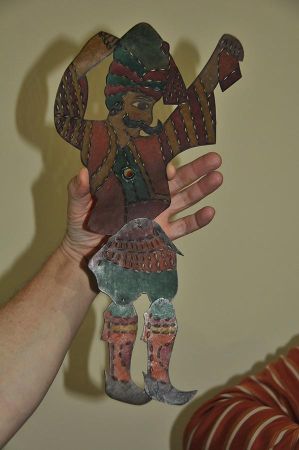 After the end of the quarrel between Karagöz and Hacivat, different characters come up to the scene and animate a different story according to the flow of play. At the end of play, Hacivat leaves the scene by saying ‘you destroyed the scene, made it ruinous’ and Karagöz ends the scene by saying ‘excuses if we slip of the tongue howsoever’ and the play is over.
After the end of the quarrel between Karagöz and Hacivat, different characters come up to the scene and animate a different story according to the flow of play. At the end of play, Hacivat leaves the scene by saying ‘you destroyed the scene, made it ruinous’ and Karagöz ends the scene by saying ‘excuses if we slip of the tongue howsoever’ and the play is over.
Karagöz plays, which used to criticize the daily events in a humorous way in the past, were later put on stage based on the memorization of the written texts because of various reasons after the Administrative Reforms and the improvisation tradition was thus abandoned. Broadening the art of Karagöz like it was in the past will only be possible if the improvisation tradition is adopted again.
Portrayals made of leather and painted with madders since the time of Şeyh Küşteri were coming into life in Hayali’s hands.
The person performing Karagöz plays is called “HAYALI”, and Hayali’s assistant is called “Yardak”. Hayali title is given to the ones by their masters after performing as an accomplice (assistantship, apprenticeship) to a master for many years and gaining the full ability and talent to perform Karagöz and Hacivat completely. Nobody could come up to the scene by saying “I am Hayali”.
A real Karagöz master makes his characters from leather by using madder and vocalizes all characters with different tone of voice and different accents (including female voice).
Emin Senyer
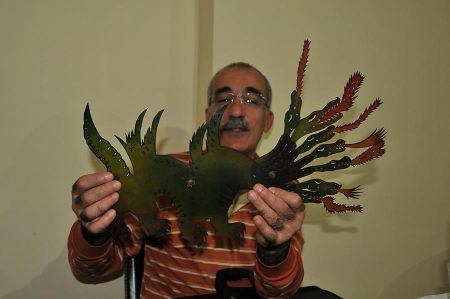 I grew up close to the Hayali Safderi Metin Özlen, who is one of the biggest masters of Karagöz art for all times. One day in a documentary of TRT, my master has given me the Hayali title and also a Pseudonym, and said
I grew up close to the Hayali Safderi Metin Özlen, who is one of the biggest masters of Karagöz art for all times. One day in a documentary of TRT, my master has given me the Hayali title and also a Pseudonym, and said
“You craft the leather very well; in the past those who process the leather well were called ‘saraç’, so let your name be Hayali Saraç Emin”
and gave me greatest honor of my life. And I was able to start performing Karagöz professionally only after that time.
Note : Puppets are made by Emin Senyer.
More Information about Karagoz and Hacivat please click here!
Background information on the Karagöz Theatre
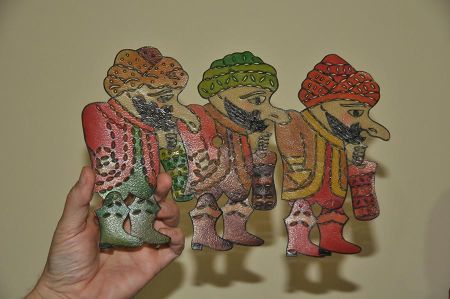 The main characters are Karagöz and Hacevit. Karagöz is a cheerful, simple, but witty and cunning man from the people. He is a rough, sensual character who, due to a lack of money, often has to take on tasks that he is not up to (e.g. writing letters for others). Hacivat is an educated representative of the urban educated class and Karagöz's polite neighbour. In addition to these two characters, other characters appear in the Karagöz Theatre. These are representatives of Istanbul society and the various religious and ethnic groups of the Ottoman Empire, but also representatives of marginal groups and mythical creatures.
The main characters are Karagöz and Hacevit. Karagöz is a cheerful, simple, but witty and cunning man from the people. He is a rough, sensual character who, due to a lack of money, often has to take on tasks that he is not up to (e.g. writing letters for others). Hacivat is an educated representative of the urban educated class and Karagöz's polite neighbour. In addition to these two characters, other characters appear in the Karagöz Theatre. These are representatives of Istanbul society and the various religious and ethnic groups of the Ottoman Empire, but also representatives of marginal groups and mythical creatures.
Traditionally, the shadow play was performed during the fasting month of Ramadan and at circumcision festivals. The performances took place in coffee houses, in the private homes of wealthy citizens, but also at the Sultan's court. The figures are made of dyed, translucent cow or camel leather, are movable and usually 20-40 centimetres high. They are pressed against a fabric lit by oil lamps or candles and moved with sticks.
All shadow puppets are operated by a single Karagöz player. He speaks the voices of the various figures, also sings songs and provides accompanying sounds.
Please also read:
Kalalahara Corbasi - Invitation to dinner at Emin Senyer's
Almost a national dish - Hamsi fried anchovies
-
 Emin Senyer explaining his figures
Emin Senyer explaining his figures
Emin Senyer explaining his figures
Emin Senyer explaining his figures
-
 Emin Senyer explaining his figures
Emin Senyer explaining his figures
Emin Senyer explaining his figures
Emin Senyer explaining his figures
-
 Emin Senyer explaining his figures
Emin Senyer explaining his figures
Emin Senyer explaining his figures
Emin Senyer explaining his figures
-
 Emin Senyer explaining his figures
Emin Senyer explaining his figures
Emin Senyer explaining his figures
Emin Senyer explaining his figures
-
 Emin Senyer explaining his figures
Emin Senyer explaining his figures
Emin Senyer explaining his figures
Emin Senyer explaining his figures
-
 Emin Senyer explaining his figures
Emin Senyer explaining his figures
Emin Senyer explaining his figures
Emin Senyer explaining his figures
-
 Emin Senyer explaining his figures
Emin Senyer explaining his figures
Emin Senyer explaining his figures
Emin Senyer explaining his figures
-
 Emin Senyer explaining his figures
Emin Senyer explaining his figures
Emin Senyer explaining his figures
Emin Senyer explaining his figures
-
 Emin Senyer explaining his figures
Emin Senyer explaining his figures
Emin Senyer explaining his figures
Emin Senyer explaining his figures
https://www.alaturka.info/en/culture/theatre/2277-galanty-show-karagoez-and-hacivat#sigProId9d818791c9
